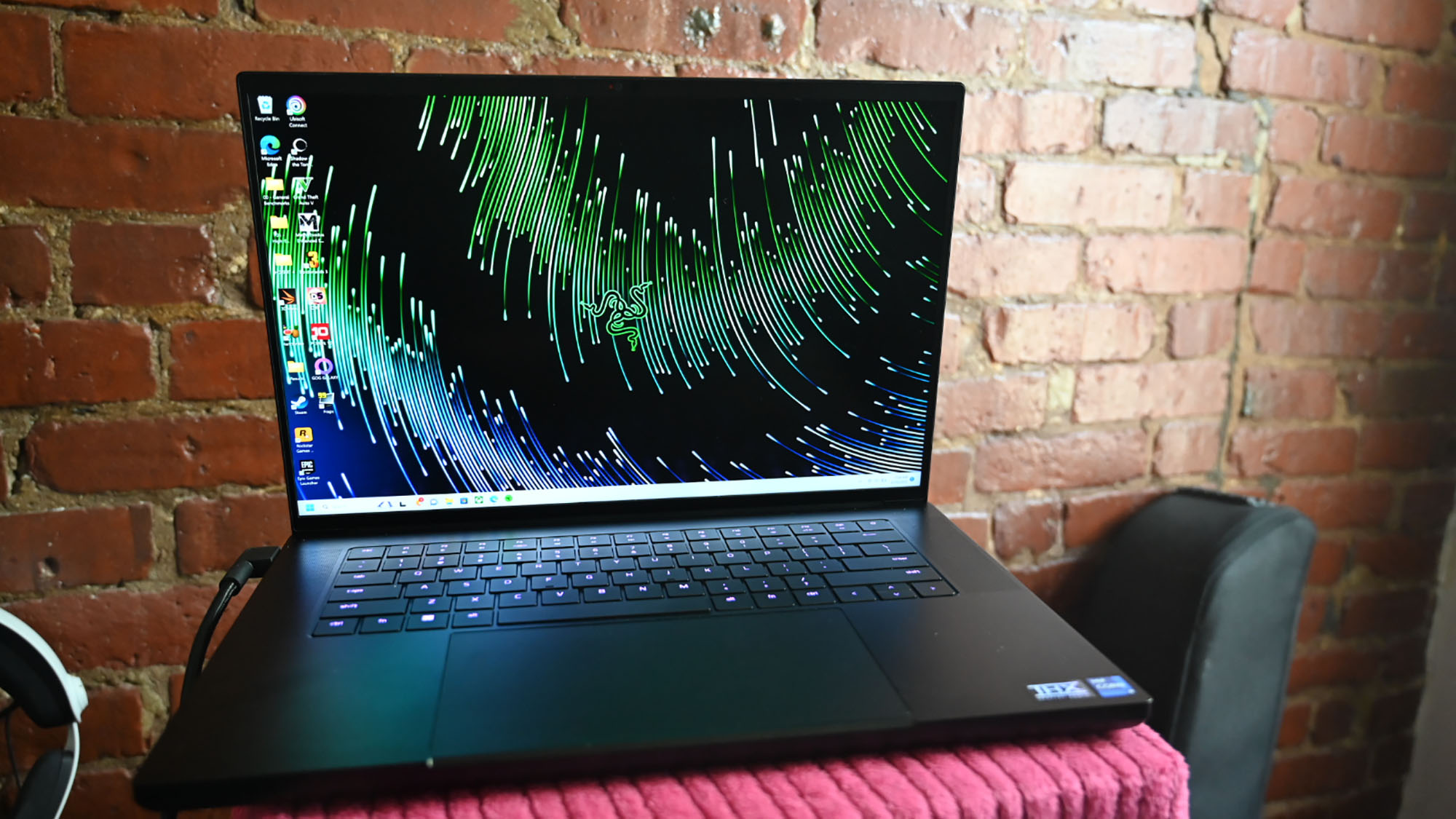Laptop Mag Verdict
The Razer Blade 16 features a dynamic display, while dealing out potent performance
Pros
- +
Strong overall and gaming performance
- +
Bright, vivid dual-mode display
- +
Great audio performance
- +
Improved user-friendly Razer Synapse app
Cons
- -
Sluggish file transfer
- -
Have to restart laptop to switch between dual modes
- -
On the pricier side of gaming laptops
Why you can trust Laptop Mag
Price: $4,299
CPU: Intel Core i9-13950HX
GPU: Nvidia GeForce RTX 4090
RAM: 32GB
Storage: dual 1TB SSDs
Display: 16-inch, 4K, 120Hz/1920x 1200, 240Hz
Battery: 95.2Whr, 5:29
Size: 14 x 9.6 x 0.87 inches
Weight: 5.4 pounds
New screen size, who dis? Razer is the latest laptop OEM to switch from odds to evens when it comes to screen size. The Razer Blade 16 brings that sleek, minimalist design that we know and love from the company — along with some cool bells and whistles such as the overclockable Intel Core i9 processor and Nvidia GeForce RTX 4090 GPU — making it one of the most powerful gaming laptops on the market.
But there’s more than that. Check out the display, the 16-inch, 16:10 mini-LED is absolutely stunning, bursting with color and seriously sharp detail. Razer could have just gone with a regular 4K display, but never afraid to buck convention, the company has unveiled the world’s first dual-mode mini-LED panel with the ability to switch between 4K resolution with a 120Hz refresh rate and 1920 x 1200 with a 240Hz refresh rate. Essentially giving gamers and content creators the best of both worlds, the laptop is designed to deliver an optimal visual experience no matter what you’re doing. Throw in a bunch of ports, a comfy, colorful keyboard, some great audio, and you’ve definitely got yourself a winner worthy of sitting on our best gaming laptops page.
But at $4,299, I expect faster file-transfer speeds and a smoother transition between display modes. If you want a powerful gaming laptop that sits on the cutting edge, read on to learn the ins and outs of the Razer Blade 16.
Razer Blade 16 Pricing and Configuration
You’re going to be spending a pretty penny for the Razer Blade 16 no matter which configuration you settle on. The base model, for instance, costs $2,699 and has a 2.2-GHz Intel Core i9-13950HX processor with 16GB of RAM, a 1TB PCIe 4.0 NVMe M.2 SSD, Intel UHD Graphics, an Nvidia GeForce RTX 4060 GPU with 8GB of VRAM and a 16-inch, 2560 x 1600 display with a 16:10 aspect ratio and a 240Hz refresh rate.
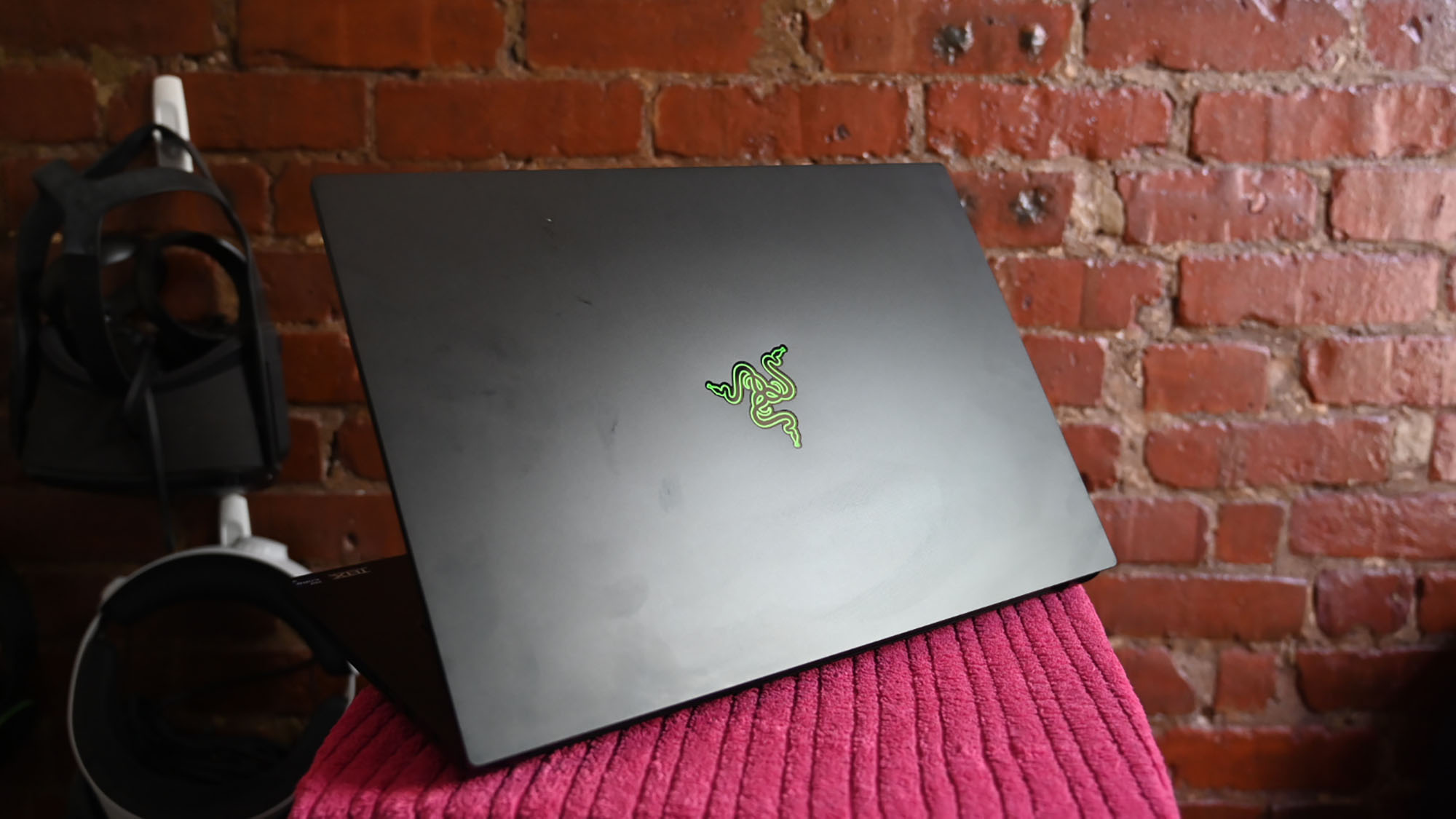
I had a blast taking the top-tier configuration for an extended spin. The notebook costs $4,299; it doubles the RAM and adds an additional 1TB PCIe 4.0 NVMe M.2 SSD. It also bumps you up to a RTX 4090 GPU with 16GB of VRAM and upgrades you to a dual-mode mini-LED display, which switches between 3840 x 2400 with a 120Hz refresh rate and 1920 x 1200 at 240Hz.
If you want to save a few dollars, there’s the $3,299 model with 32GB of RAM, a 1TB PCIe 4.0 NVMe M.2 SSD and an RTX 4070 GPU with 8GB of VRAM and the dual-mode display.
Razer Blade 16 Design
The size might have changed, but the Razer Blade 16’s good looks remain. The notebook’s chassis is made of black, fingerprint resistant CNC aluminum. The lid is bare save the company’s three-headed snake emblem that glows that eerie neon green. The corners are gently rounded as is the front and back of the laptop’s undercarriage.
Sign up to receive The Snapshot, a free special dispatch from Laptop Mag, in your inbox.

If you’re familiar with Razer laptops, it comes as no surprise that the notebook’s interior has more of that cool-to-the-touch ebony aluminum. The per-key RGB keyboard backlighting is bright and colorful nestled between a pair of large speaker grilles. An absolutely massive touchpad rests directly below, taking up most of the palm rest. The bezels surrounding the 16-inch display are slim, but I wish the top bezel was just a little slimmer. That’s me nitpicking, but I want as much screen real estate as possible.
The Blade 16 measures 14 x 9.6 x 0.87 inches and weighs 5.4 pounds. That’s a bit heavier than the Asus ROG Zephyrus M16 (5 pounds, 13.9 x 9.7 x 0.9 inches), but lighter than both the MSI Titan GT77 (7.3 pounds, 15.6 x 12.9 x 0.9 inches) and Alienware m17 R5 AMD Advantage (7.3 pounds, 15.6 x 12.9 x 0.9 inches).
However, the last two are 17-inch laptops which is to be expected. (See also: 💻 Our guide to the best 17-inch laptops.)
And while it’s not a gaming laptop, I’m throwing the 4.8-pound, 14 x 9.8 x 0.7-inch Apple MacBook Pro 16 (M2 Max) into the mix as it’s just as pricy and powerful as the others in the cohort.
Razer Blade 16 Ports
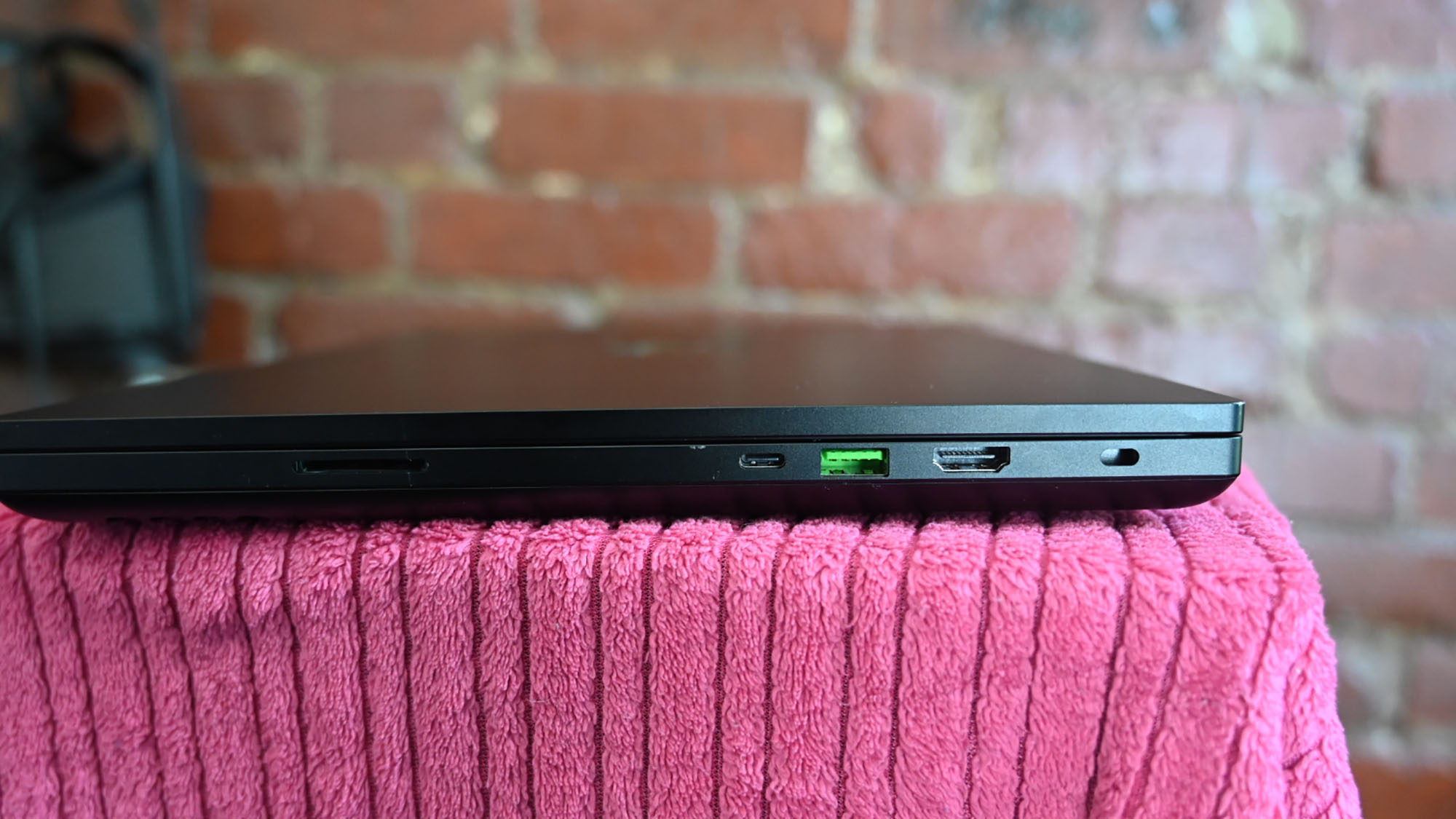
The Blade 16 is bursting at the seams with ports, starting with the right, which has a USB Type-A 3.2 Gen 2 port, a USB Type-C 3.2 Gen 2 port, HDMI 2.1, a UHS-II SD Card Reader and a Kensington lock slot. On the left, you have a pair of USB Type-A 3.2 Gen 2 ports, a USB Type-C 3.2 Gen 2 port, a headset jack and Razer’s proprietary power port.
Razer Blade 16 Display
At first glance, the matte 16-inch display with its 16:10 aspect ratio looks like every other display you’ve seen on a gaming laptop. However, this panel is more than meets the eye. First off, it’s one of the first gaming laptops to feature a mini-LED screen, which tend to be brighter and more vivid than an OLED panel. And while that’s cool, the real story here is that this is the first gaming laptop to feature a dual-mode panel, allowing gamers to switch between Creator and Gamer modes in a best-of-both-worlds scenario.
When it’s time to edit photos or video, there’s Creator mode, which adjusts the screen to 3840 x 2400 resolution with a 120Hz refresh rate, which, if you really wanted to, is more than acceptable for some high-quality gaming. But if you want lighting-fast rendering with minimal input lag that leads to better accuracy, you want Gaming mode, which dials down the resolution to 1920 x 1200 with a blistering 240Hz refresh rate.

With its higher resolution, Creator mode gives you more pixels to work with as well as 100% of the DCI-P3 color gamut. However, in order to switch modes, you need to adjust the setting in Razer’s Synapse app and reboot, which is a slight hassle.
I watched the Blue Beetle trailer in both modes. In Creator Mode, I could see the off-putting, creases and folds in the royal blue chitinous armor of the extraterrestrial Scarab in Creator Mode. The glistening inky black liquid that rapidly oozed over actor’s Xolo Maridueña’s face enveloping him in a semi-horror movie scenario was hypnotizing.
| DCI-P3 color gamut percentage | |
| Razer Blade 16 | 93% |
| Alienware m17 R5 | 76.2% |
| MacBook Pro 16 | 83.7% |
| MSI GT77 Titan | 114.5% |
I didn’t notice any real detail degradation when watching the same scene in Gaming mode. After watching the trailer several times in both modes, I did notice that smaller things like the sparks that occurred from Blue Beetle cutting a bus in half weren’t as defined in Gaming mode. Again, it’s a small complaint, but it does exist.

My only concern with switching between modes is that the text scaling doesn’t automatically adjust. In the switch up from Creator to Gaming mode, I found the text and the apps were often larger than normal (150% vs 100%), forcing me to go into Settings to scale everything back down to a comfortable reading size. It’s a minor detail, but if you’re constantly changing modes, it’s an extra step that I wish was automatic.
| Display brightness (Nits) | |
| Razer Blade 16 | 467 |
| Alienware m17 R5 | 436 |
| MacBook Pro 16 | 447 |
| MSI GT77 Titan | 511 |
The Blade 16 showed its true colors when we measured for the DCI-P3 color gamut, the system measured 93% of the gamut, which is better than the 87.9% premium gaming laptop average, the MacBook Pro’s 83.7% the m17 R5’s 76.2%. It was not more vivid than the Titan however, which had a score of 114.5%.
During our brightness test, the Blade 16 averaged 467 nits, surpassing the 383-nit average, the MacBook Pro’s 447 nits and the Alienware’s 436 nits, but not the Titan’s 511 nits.
Razer Blade 16 Audio
The Razer Blade 16’s four speaker setup is loud and produces relatively clean audio. However, with songs like Victoria Monét’s “Smoke,” the highs can dance on the edge of being shrill. Thanks to a pair of subwoofers, the Blade 16 offers a fair amount of bass as I learned while listening to Megan Thee Stallion’s “Her” with its thumping bassline.
If you want a more immersive experience when gaming or watching movies, there’s the THX Spatial Audio for PCs app. It’s here that you can toggle between THX Stereo or THX Spatial Audio with the latter creating the illusion of a 3D soundscape for a more immersive experience. So when I tossed a grenade into a wave of incoming enemies in Cyberpunk 2077, the resulting boom sounded like it went off from my left instead of just a centrally-located bang.
In Stereo or Spatial Audio mode, the Game preset gave me the best experience whether I was fighting my way through a gang of cyberthugs, listening to music or watching a movie.
Razer Blade 16 Keyboard and Touchpad
Beauty, comfort and clickiness. That’s what’s in store when you start typing on the Razer Blade 16’s island-style keyboard. The keys have nice spacing and depress with a satisfying click and springy feedback. The per-key backlighting is lovely and highly customizable thanks to the Razer Synapse 3 software. You can either use one of the eight quick settings (Breathing, Fire, Reactive, Ripple, Spectrum Cycling, Starlight, Static and Wave) or take a more hands-on approach with Advanced Settings and build out something more unique via Chroma Studio.
Synapse 3 is also where you can create macros for both the keyboard or a Razer mouse among other things.
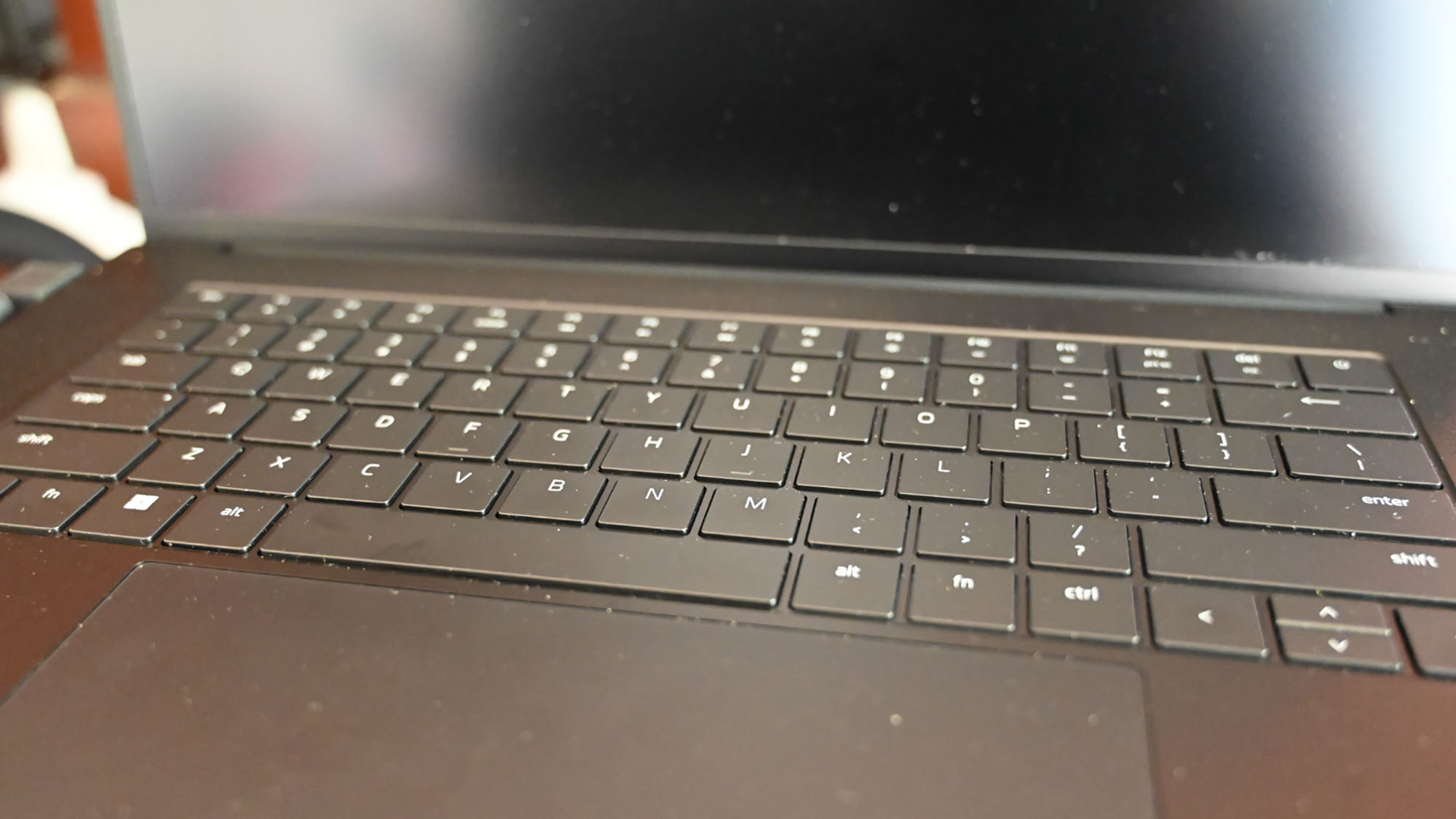
Beauty aside, I had a good time typing on the Blade 16’s keyboard. I easily reached 80 words per minute on the 10fastfingers typing test with 99% accuracy. That is significantly better than my normal 70 wpm/99% accuracy.
At 6.8 x 3.9 inches, the Blade 16’s trackpad is an absolute unit. And despite its massive size, the smooth glass touchpad offers great palm rejection, allowing me to work normally without the cursor veering off into space. Multitouch gestures such as two-finger scroll, pinch-zoom and three-finger press were instantaneous and accurate.
Razer Blade 16 Gaming and Graphics
The Blade 16 is the latest gaming laptop to join the 4090 club. With its Nvidia GeForce RTX 4090 GPU with 16GB of VRAM, it’s one of the most powerful gaming systems on the market. But how does it hold up against systems that are equally or close to rocking comparable specs? Swimmingly.
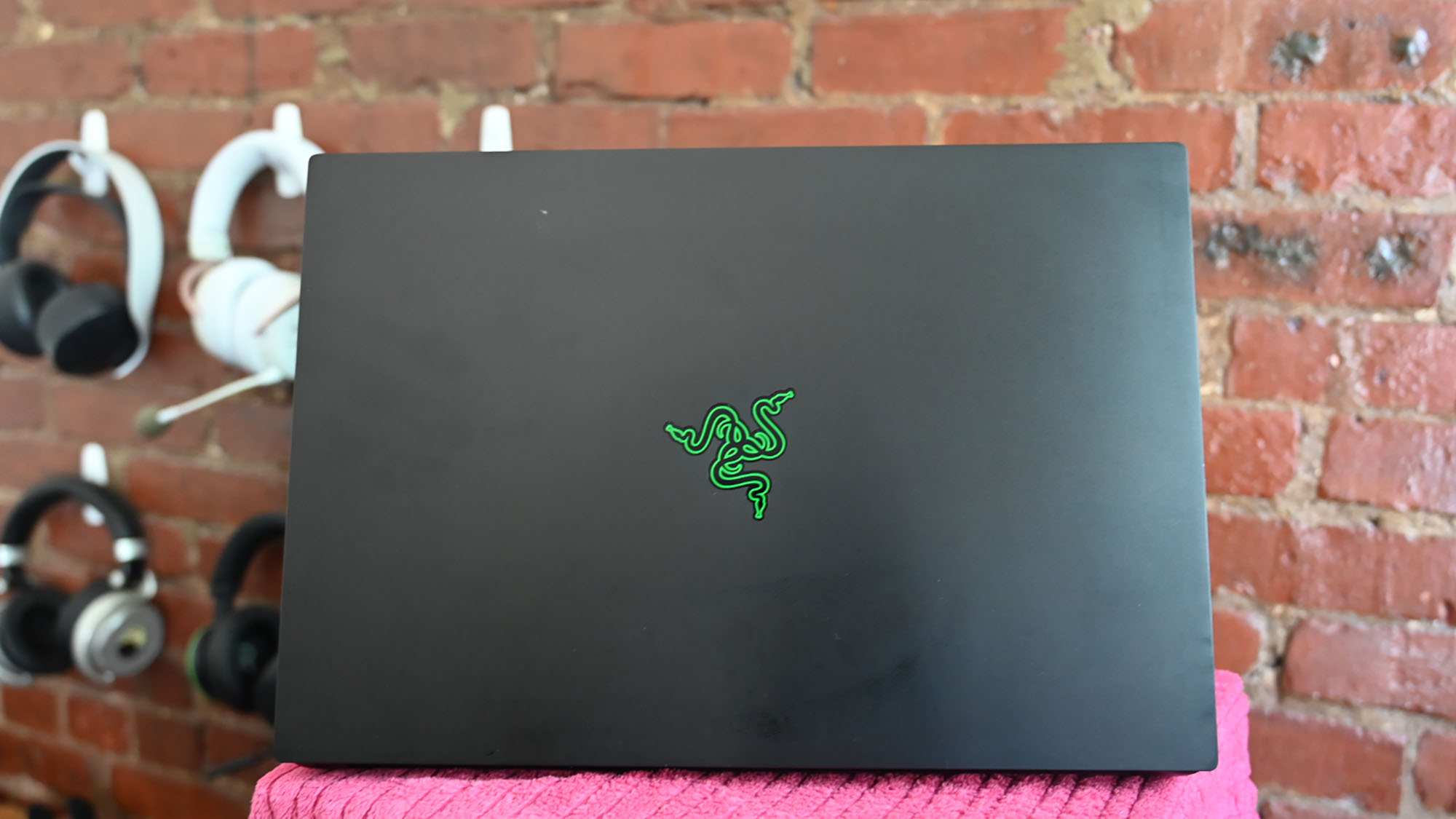
Now onto our synthetic benchmarks, starting with Assassin’s Creed Valhalla where the Blade 16 hit 144 fps at 1080p, destroying the 103-fps premium gaming laptop average. With its own 4090 GPU, the Titan wasn’t too far behind at 124 fps. The m17 R5 AMD Radeon RX 6850M XT) brought up the rear with a respectable 112 fps.
When we switched over to 4K, the Blade 16’s frame rate dropped to 65 fps, which is just below the 71-fps average, but better than Alienware’s 44 fps, but short of the Titan’s 76 fps.
| 1920 x 1080 (fps) | 4K (fps) | |
| Razer Blade 16 | 144 | 65 |
| Alienware m17 R5 | 112 | 44 |
| MSI GT77 Titan | 124 | 76 |
On the Shadow of the Tomb Raider test, the Blade 16 scored a solid 159 fps, slipping past the 122-fps category average and the m17 R5’s 99 fps at 1080p. The Titan continued to show up the competition, producing 180 fps. At 4K, the Razer reached 56 fps, beating the Alienware’s 43 fps, but coming nowhere near either the Titan’s 70 fps or the 73-fps category average.
The Blade 16 posted 164 fps on the Grand Theft Auto V benchmark, shattering the 125-fps average as well as the Alienware’s 104 fps. But once again, the MSI came out victorious with a score of 176 fps. Running the benchmark at 4K resolution yielded lower frame rates across the board, starting with the Blade 16’s 43 fps. It’s below the 70-fps premium gaming laptop average, but so are Titan and Alienware with 50 and 33 fps, respectively.
| 1920 x 1080 (fps) | 4K (fps) | |
| Razer Blade 16 | 164 | 43 |
| Alienware m17 R5 | 104 | 33 |
| MSI GT77 Titan | 176 | 50 |
We encountered a tie on the Far Cry 6 benchmark between the Blade and the Titan at 102 fps. The score is well above the 89-fps average and the m17 R5’s 81 fps. Jacking the resolution up to 4K broke the tie with the Blade 16 reaching 59 and the Titan obtaining 71 fps. The Alienware only managed 43 fps, a full 30 frames below the 73-fps category average.
When we ran the Borderlands 3 test, the Razer hit 142 fps, which is not too shabby, especially considering the 110-fps average. The Alienware got 112 fps while the MSI’s 177 fps stole the show. At 4K resolution, the Razer, Alienware and MSI scored 54, 44 and 71 fps with only the Titan surpassing the 68-fps average.
| 1920 x 1080 (fps) | 4K (fps) | |
| Razer Blade 16 | 102 | 59 |
| Alienware m17 R5 | 81 | 43 |
| MSI GT77 Titan | 102 | 77 |
During the Red Dead Redemption 2 benchmark, Blade 16 reached 111 fps, besting the 82-fps category average and the m17 r5’s 76. But it couldn’t topple the Titan’s 127 fps. The Blade 16 obtained an impressive 77 fps at 4K, handing a defeat to the MSI (48 fps) and Alienware (24 fps) as well as the 52-fps category average.
And for those times you aren’t blasting through bad guys or creating multimedia content, the laptop relies on its integrated Intel UHD Graphics GPU.
Razer Blade 16 Performance
There wasn’t much I could throw at the Razer Blade 16 that it didn’t shrug off. The laptop’s 2.2-GHz Intel Core i9-13950HX CPU with 32GB of RAM and dual 1TB SSDs laughed off my 80-plus tabs with its random assortment of Google Docs, Sheets and Presentations as well as my YouTube videos, Twitch streams and various social media feeds.
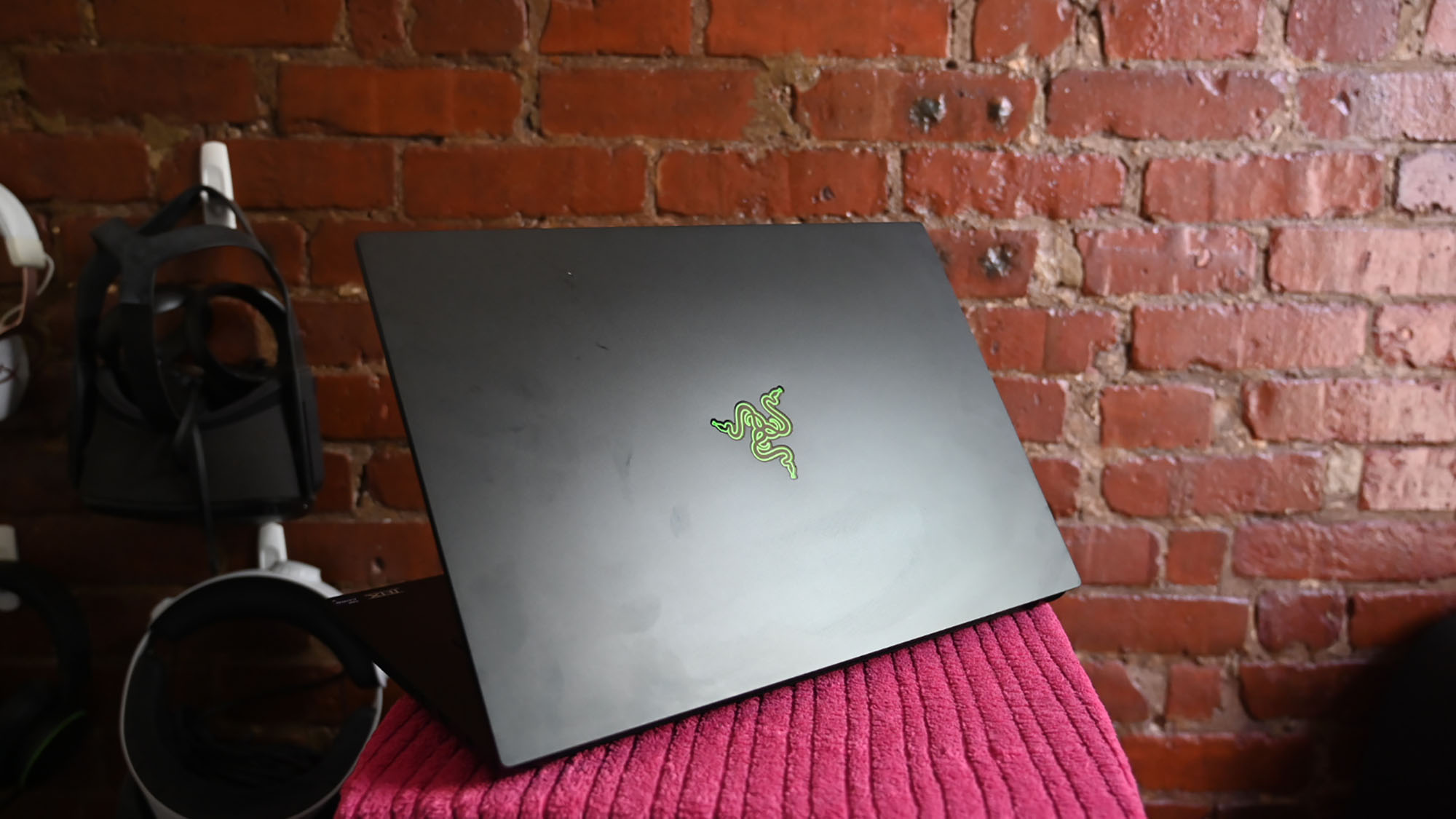
The notebook also did well on our synthetic testing. For instance on Geekbench 5.4, an overall performance benchmark, the Blade 16 reached 13,769, scorching the 9,441 premium laptop average. The Alienware m17 R5 (AMD Ryzen 9 6900HX) also got cooked with a score of 9,851. But the Zephyrus (Intel Core i9-13900H), MacBook Pro (M2 Max CPU) and Titan (Intel Core i9-13980HX) turned the tables, producing results of 13,817, 15,044 and 20,617, respectively.
| (mm:ss) | |
| Razer Blade 16 | 4:08 |
| Asus ROG Zephyrus M16 | 4:17 |
| Alienware m17 R5 | 5:30 |
| MacBook Pro 16 | 3:59 |
| MSI GT77 Titan | 2:38 |
The Blade 16 completed our video transcoding test (transcoding 4K video to 1080p) in 4 minutes and 8 seconds. It’s faster than the 4:39 category average as well as the Zephyrus (4:17) and the Alienware (5:30). However, the Titan and the MacBook Pro proved to be the fastest laptop in town with a time of 2:38 and 3:59.
Even though the Blade 16 has been holding its own until this point, I was disappointed to see how hard the gaming laptop stumbled on our file transfer test. The dual 1TB SSDs gave us a transfer rate of 972.2 megabytes per second. That’s well below the 1,498.3MBps average, not to mention the m17 R5 (2TB PCIe NVMe M.2 SSD) and MSI (2TB M.2 NVMe PCIe Gen 4 SSD) which notched 1,766.7MBps and 2,299.3MBps.
Razer Blade 16 Battery Life
With the Razer Blade 16’s power, you’d expect an inordinately short battery life. That’s not the case, the Blade 16 actually lasted 5 hours and 29 minutes on the Laptop Mag battery test (continuous web surfing over wi-fi at 150 nits of brightness). It’s much better than the battery life of old or even now as the Titan only lasted 3:48. The Blade’s time is just short of the 5:38 premium gaming laptop average. The Alienware was the last gaming laptop running at 6:07, but the crown for longest lasting overall goes to the MacBook and it’s ridiculous 18:59.
However, when we ran the PCMark 10 test, which runs on a continuous script to simulate a gaming experience, the Blade 16 only lasted 1:30. That’s on a par with most gaming laptops on the market.
Razer Blade 16 Heat
For a laptop with an all-metal chassis and higher-end specs, I expected the Razer Blade 16 to be a serious crotch burner, especially when gaming. But I was pleasantly surprised that the Blade 16 managed to keep things relatively cool for a gaming laptop.
I played Witcher 3 for 15 minutes and measured the key points on the laptop, including the touchpad and center of the keyboard. Both registered 97 and 96 degrees Fahrenheit, respectively –– just slightly above our comfort threshold. The laptop’s undercarriage was noticeably hotter at 114 degrees with the rear towards the hinge reading 124 degrees. It should be noted that I played Witcher for about an hour with the system on my bare legs with no ill effect.
After allowing the system to cool down, we played a 15-minute fullscreen video and remeasured. The temperatures were much cooler with the touchpad measuring 85 degrees while the middle of the keyboard and laptop bottom reached 93 and 96 degrees each.
Razer Blade 16 Webcam
The Blade 16’s 1080p webcam will definitely work in a pinch for streaming, but I’d still recommend checking out our best webcams page as the detail isn’t as sharp as I would like. In the test shots I took, the shooter did a good job capturing my skin tone including my blush-enhanced cheeks. The color of my black and red frock was spot on as was the pine green faux jewel on my necklace.

Although the slight creases and folds in my dress were plainly visible, my forehead looked like I had a filter enabled. And there was some mild blowout on the lights and the windows. Zooming in on the photos revealed plenty of visual noise, but that’s to be expected.
I really appreciate that Razer added a physical shutter to the webcam. While I mentally know that a digital kill switch works just as well as a shutter, I feel better pulling the switch into place.
Razer Blade 16 Software and Warranty
Razer’s Synapse app got a major and sorely needed redesign that brings more functionality to the table. Aside from creating light shows and macros, Synapse 3.0 app can create custom global shortcuts of key combinations that work across any Synapse 3.0-compatible device. You also have the ability to enable/disable Gaming Mode, modify trackpad settings and Fn and Multimedia key functionality. And of course, you can change resolution and refresh rate as it pertains to the laptop and a secondary monitor. There’s even a battery health optimizer and that’s just scratching the surface of what the app can do.

Outside of Nvidia GeForce Experience, which brings a host of gamercentric features, the Blade 16 is delightfully free of bloatware.
The Razer Blade 16 ships with a one-year limited warranty and a two-year battery warranty. See how Razer fared during Tech Support Showdown, our annual special feature.
Bottom Line
Big, bold, beautiful and seriously expensive, the Razer Blade 16 is bursting at the seams with power. It’s got those stunning good looks you’ve come to expect from Razer with an all-metal chassis that stays surprisingly cool when gaming (at least for a gaming system). It’s also got a plethora of ports and a super comfortable keyboard, but the showstoppers are the Nvidia GeForce RTX 4090 GPU and Intel Core i9 processor, overclockable specs that make the Blade 16 a lean, mean gaming machine.
And lest we forget the world’s first Dual-Mode panel. I know it’s easy to write something like this off as a chintzy gimmick. But if you’re a gamer looking for a super high-res panel with a high refresh rate or a content creator or consumer on the hunt for a gorgeous 4K screen with great color accuracy, you’re in the right place. With an in-app button toggle, you’re essentially getting two high-performance panels in one beautiful mini-LED screen. Could the switch be smoother? Sure, but hopefully Razer will address this in the next iteration.
But as cool as the Razer Blade 16 is with all its extra bells and whistles, it’s also incredibly expensive. At $4,299, I expect to get the best of everything. The laptop was consistently bested by the ($5,299) MSI Titan GT77, which granted is $1,000 more. And that file transfer speed definitely leaves something to be desired. However, switching between gaming and content creation on the fly is your thing, the Razer Blade 16 definitely deserves a deeper dive.

Sherri L. Smith has been cranking out product reviews for Laptopmag.com since 2011. In that time, she's reviewed more than her share of laptops, tablets, smartphones and everything in between. The resident gamer and audio junkie, Sherri was previously a managing editor for Black Web 2.0 and contributed to BET.Com and Popgadget.
